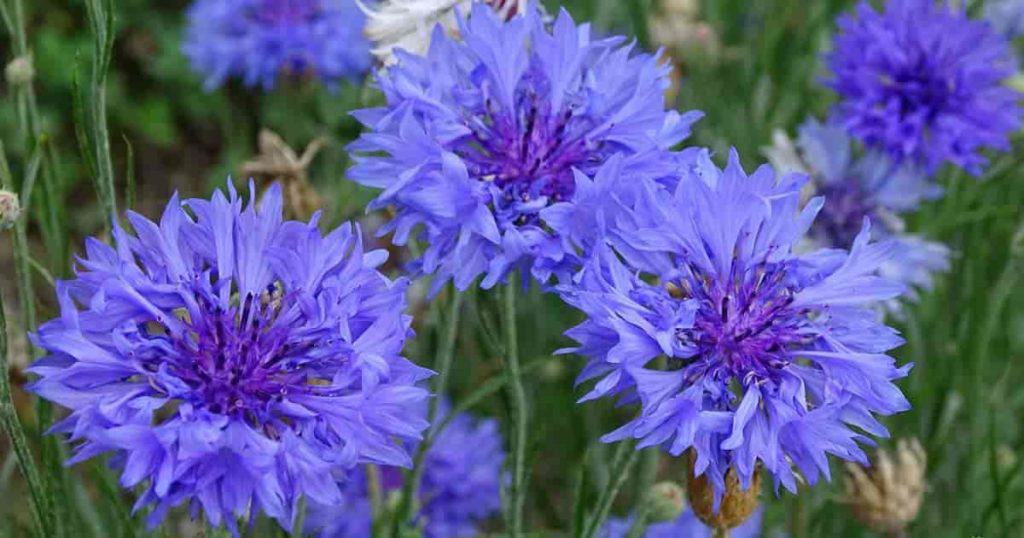Centaurea cyanus (aka Bachelor Button, Bluebottle or Cornflower) is a hardy, carefree annual flower.
The drought-tolerant naturalized wildflower comes in several attractive shades of pink, red, purple and blue.

Once planted, this tall, hardy, self-seeding, Bachelor Button plant returns year after year, providing valuable food and habitat for birds, bees and butterflies along with a host of other pollinators.
Centaurea cyanus [sen-TAR-ee-uh SY-an-us] are members of the Asteraceae [ass-ter-AY-see-ee] or daisy family hailing from Europe and western Asia. There are many members in the Centaurea genus.
The plant’s genus name comes from the Greek word meaning centaur (kentauros) and the species (cyanus) meaning blue.
Caring For Bachelor Button Plants
Size & Growth
Bachelor’s Button grows between 1′ – 3′ feet tall with plants spreading as wide as 1′ to 2′ feet tall. Each plant needs at least 6″-12″ inches of space all around to grow well.
As your cornflower seedlings develop, thin out the weaker ones to make more room for the stronger plants.
Flowering & Fragrance
Flowers may be white, pink, red, lavender, blue or purple. They bloom from late in the spring and throughout the summer. The slightly fragrant flowers attract butterflies and other pollinators, and the seeds attract birds.
Foliage: The foliage is silvery blue and Lance shaped.
Light & Temperature
Bachelor’s Buttons are cool weather annuals and very easy to grow in any place with:
- Medium moisture
- Average well-drained soil
- Lots of sunlight
They can also do reasonably well in light shade and recommended for USDA hardiness zones 2-11.
Watering & Feeding
Mature cornflower plants do well with deep, occasional watering. If your area receives regular rain during the growing season, you may not need to water at all.
Fertilizing is not necessary. Just apply a layer of organic compost at the end of the growing season to enrich the soil for the coming year.
Soil & Transplanting
Centaurea plants do well in any moderately fertile, well-draining soil. Transplanting is unnecessary as sowing seed in new locations is a simple matter and sure to be successful.
Grooming & Maintenance
Throughout the plants’ growing season, pinch back any dead or broken limbs or leaves. When plants are still young, pinch them back regularly to encourage a bushy growth habit.
Very tall plants may need support (ie. a peony ring) to prevent them from toppling over.
Deadhead old flowers to encourage more blooming. When deadheading the flowers place the old flower heads in a location where birds can find them. Birds are especially fond of Bachelor Button seeds.
At the end of the growing season when plants begin to die back, you can mow them down to the ground.
Use a mulching mower to mulch the plants’ leaves and stems into the soil to provide nutrition for the next year’s crop.
The flowers will self-seed. To prepare for the next growing season add a layer of organic mulch to protect the seeds through the winter and feed the new plants in the spring.
How To Propagate Centaurea Cyanus
Propagating bachelors Buttons couldn’t be easier. In the springtime, clear the ground and sow seeds directly into the soil after all danger of frost passes. The best location is full sun on well draining healthy, well-watered soil.
Seed should germinate within a week or two. Keep the soil evenly moist until the seedlings establish themselves. From there on out, provide deep watering about once a week.
Remember that these plants are wildflowers and do best with thorough, infrequent watering.
Bachelor’s Button Pest or Disease Problems
These hardy, cheery wildflowers are extremely disease and insect resistant. Although non-toxic, they are also deer and rabbit resistant.
In very wet weather, plants may have problems with powdery mildew and rust. Unhealthy plants may also attract mealybugs and aphids.
To avoid these problems, don’t use overhead watering techniques. Use a soaker hose or drip irrigation instead.
Be sure to give plants plenty of breathing space. Apply organic fungicide (Neem oil) as needed to deal with fungal infections.
Are Bachelor Buttons Considered Invasive?
Because these plants are naturalized wildflowers and highly adaptable, they may also be considered invasive.
These plants grow in a naturalized manner in many areas of the United States and southern Canada. They are especially prevalent all along the West Coast and in some areas of the East Coast.
It is common to see Bachelor’s Buttons growing with wild abandon along roadsides and train tracks, as well as in fields and abandoned lots.
Suggested Bachelor’s Button Uses
These naturalized wildflowers are excellent additions as cut flowers in arrangements. Hybrid series available – ‘Blue Boy’ and ‘Black Button’.
They do well in wildflower prairie plantings, meadows, cottage gardens, borders, flowerbeds, butterfly gardens or mixed in with other colorful, hardy flowers such as snapdragons and red poppies.
Along with other hardy, self-seeding annual and semi-perennial flowers, Bachelor’s Buttons make a good cover over bulb gardens.
They will spring up early and in advance of the bulbs in the springtime and provide a beautiful backdrop for tall flowers such as daylilies.
